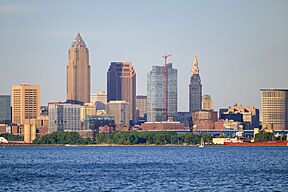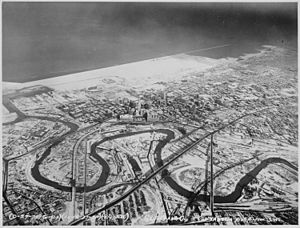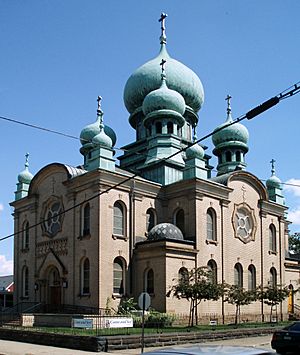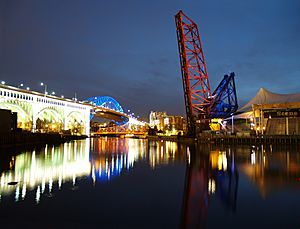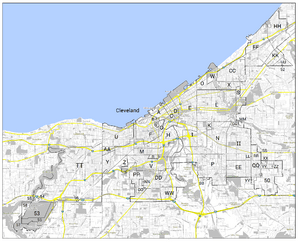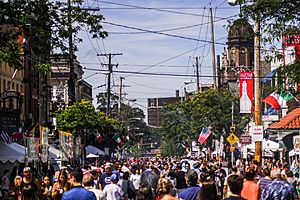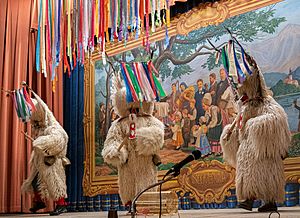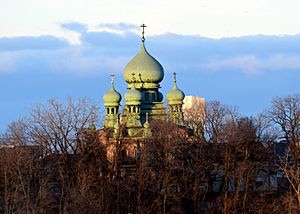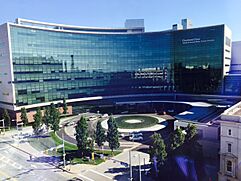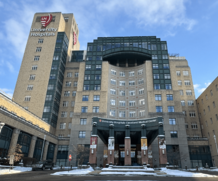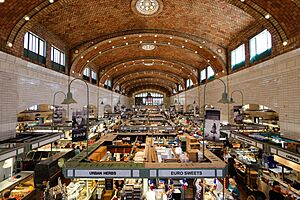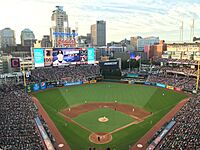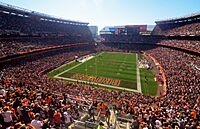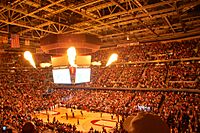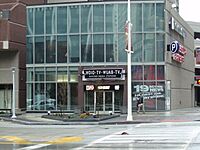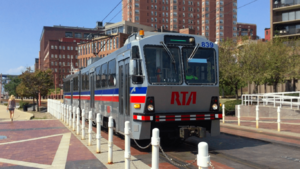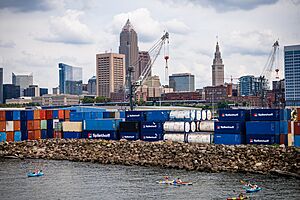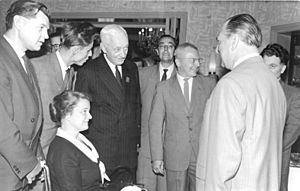Cleveland facts for kids
Quick facts for kids
Cleveland
|
|||
|---|---|---|---|
|
Cleveland script sign at Edgewater Park
Downtown Cleveland skyline
|
|||
|
|||
| Nicknames:
The Forest City
(for more, see full list) |
|||
| Motto(s):
Progress & Prosperity
|
|||
| Country | United States | ||
| State | Ohio | ||
| County | Cuyahoga | ||
| Founded | July 22, 1796 | ||
| Incorporated (village) | December 23, 1814 | ||
| Incorporated (city) | March 5, 1836 | ||
| Named for | Moses Cleaveland | ||
| Government | |||
| • Type | Strong mayor / Council | ||
| • Body | Cleveland City Council | ||
| Area | |||
| • City | 82.48 sq mi (213.62 km2) | ||
| • Land | 77.73 sq mi (201.33 km2) | ||
| • Water | 4.75 sq mi (12.29 km2) | ||
| Elevation | 653 ft (199 m) | ||
| Population
(2020)
|
|||
| • City | 372,624 | ||
| • Estimate
(2023)
|
362,656 | ||
| • Rank | 54th in the United States 2nd in Ohio |
||
| • Density | 4,793.52/sq mi (1,850.78/km2) | ||
| • Urban | 1,712,178 (US: 31st) | ||
| • Urban density | 2,398.7/sq mi (926.1/km2) | ||
| • Metro | 2,185,825 (US: 33rd) | ||
| Demonym(s) | Clevelander | ||
| GDP | |||
| • Metro | 9.935 billion (2023) | ||
| Time zone | UTC−5 (EST) | ||
| • Summer (DST) | UTC−4 (EDT) | ||
| ZIP Codes |
ZIP Codes
|
||
| Area code | 216 | ||
Cleveland is a large city in the U.S. state of Ohio. It is the main city of Cuyahoga County. Cleveland is located on the southern shore of Lake Erie. It is about 60 miles (97 km) west of Pennsylvania.
Cleveland is the biggest city on Lake Erie. It is the second-largest city in Ohio. In 2020, about 372,624 people lived there. The city is the center of the Cleveland metropolitan area, which has over 2 million residents.
The city was started in 1796 by General Moses Cleaveland. It was built near the Cuyahoga River and Lake Erie. This location helped it become a major center for business and industry by the late 1800s. Many immigrants and migrants moved to Cleveland. For much of the 1900s, it was one of the 10 largest cities in the U.S.
Cleveland is a port city. It connects to the Atlantic Ocean through the Saint Lawrence Seaway. Today, Cleveland's economy includes many different areas. These include education, manufacturing, money services, healthcare, and medical research. The city is also home to the Federal Reserve Bank of Cleveland. Cleveland is known as "The Forest City" and has many other nicknames. It is also home to the Cleveland Metroparks nature system.
Cleveland has major professional sports teams. These include the Cleveland Browns (football), the Cleveland Cavaliers (basketball), and the Cleveland Guardians (baseball).
Contents
History of Cleveland
Cleveland got its name on July 22, 1796. Surveyors from the Connecticut Land Company planned a capital city. They named it "Cleaveland" after their leader, General Moses Cleaveland. General Cleaveland planned the downtown area around Public Square. He then went home and never visited Ohio again. The first person to settle in Cleaveland was Lorenzo Carter. He built a cabin by the Cuyahoga River.
The Village of Cleaveland became official on December 23, 1814. Even with swampy areas and cold winters, its location on the water was a big plus. The city grew quickly after the Ohio and Erie Canal was finished in 1832. This canal connected the city to the Ohio River and the Great Lakes. This meant Cleveland could trade with the Atlantic Ocean and the Gulf of Mexico. More growth came with new railroad lines. Cleveland officially became a city in 1836.
In 1836, Cleveland almost had a fight with its neighbor, Ohio City. This was over a bridge connecting the two areas. Ohio City stayed separate until Cleveland took it over in 1854.
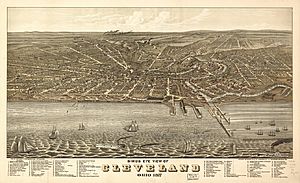
Cleveland's great location on the Great Lakes helped it become a major trade center. Iron ore from Minnesota and coal by rail came to the city. In 1870, John D. Rockefeller started Standard Oil in Cleveland. He moved its main office to New York City in 1885. In the early 1900s, Cleveland became an important manufacturing hub. Car companies like Peerless and Winton were here. Winton made the first car driven across the U.S. Because of this fast growth, Cleveland was called the "Sixth City."
By 1920, Cleveland was the nation's fifth largest city. This was thanks to its strong economy. Many important people from this time are buried in Lake View Cemetery. This includes President James A. Garfield and John D. Rockefeller.
In 1936, Cleveland held the Great Lakes Exposition. This event celebrated 100 years since Cleveland became a city. It was meant to help the city after the Great Depression. It attracted millions of visitors. The area where it was held is now home to the Great Lakes Science Center and the Rock and Roll Hall of Fame.
After World War II, Cleveland's economy was strong. Its sports teams also did very well. The Indians won the 1948 World Series. The hockey Barons won their league. The Browns were champions in football in the 1950s. Because of this, Cleveland was called the "City of Champions" in sports.
In 1949, Cleveland was named an All-America City. The city's population reached its highest point in 1950 with over 914,000 people. By the 1960s, the economy slowed down. Many people moved to the suburbs. This was a common trend across the U.S.
In the 1950s and 1960s, Cleveland faced social challenges. In 1967, Carl Stokes became the first major American city to elect a black mayor. In 1978, Cleveland had financial difficulties.
The Cleveland area slowly started to recover. Mayors George Voinovich and Michael R. White helped with this. Downtown areas were redeveloped. This included the Gateway Sports and Entertainment Complex and the North Coast Harbor. The Rock and Roll Hall of Fame and the Great Lakes Science Center were built. People started calling Cleveland the "Comeback City."
In the 21st century, Cleveland has improved its buildings and roads. Its economy is more varied. It is now well-known for its medical fields and has invested in the arts. Cleveland is seen as a good example of a city that has made a comeback. In 2014, Cleveland hosted the 2014 Gay Games. In 2016, it hosted the 2016 Republican National Convention.
Cleveland's Geography
Land and Water
Cleveland covers about 82.47 square miles (213.62 km2). Most of this is land, with some water from Lake Erie. The city is on the shore of Lake Erie, which is about 569 feet (173 meters) above sea level. However, the city itself sits on hills that rise quickly from the lake. For example, Public Square, which is less than 1 mile (1.6 km) from the lake, is 650 feet (198 meters) high.
City Layout
Buildings and Design
Cleveland's downtown buildings show many different styles. Many government buildings, like City Hall and the Cleveland Public Library, are grouped around an open area called The Mall. They share a similar neoclassical architecture style. These were built in the early 1900s as part of the "City Beautiful" movement.
The Terminal Tower, finished in 1930, was the tallest building outside New York City for many years. It was the tallest in Cleveland until 1991. Newer skyscrapers like Key Tower (the tallest in Ohio) mix old and new styles. Another famous building is The Arcade, a five-story shopping area built in 1890. It is now a hotel. Cleveland also has beautiful churches, like the historic Old Stone Church and the onion domed St. Theodosius Russian Orthodox Cathedral.
Euclid Avenue was once known as "Millionaire's Row." It was home to famous people like John D. Rockefeller.
City Areas
Downtown Cleveland is around Public Square. It has many different areas. This includes the Financial District and the Cleveland Theater District. Areas like the Flats and the Warehouse District have businesses, restaurants, and bars. More people have been moving into downtown apartments and lofts since 2000.
Clevelanders often say they live on the "east side" or "west side" of the Cuyahoga River. The east side includes neighborhoods like University Circle and Little Italy. The west side has areas like Ohio City and Tremont. Some neighborhoods in the Cuyahoga Valley are called the "south side."
Some inner-city neighborhoods have been improving and attracting new residents. This has led to new homes being built.
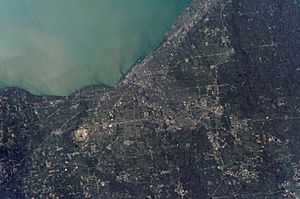
Nearby Towns
Cleveland has many older towns right next to it, called inner-ring suburbs. These include Lakewood, Cleveland Heights, and Parma. Many of these towns work together to improve their communities.
Weather
Cleveland has a continental climate with four clear seasons. Summers are warm and humid. Winters are cold and snowy. Because of Lake Erie, Cleveland often gets "lake effect snow" from mid-November until the lake freezes. This means the east side of the city and the "Snow Belt" can get a lot more snow than the west side.
The hottest temperature ever recorded in Cleveland was 104°F (40°C) on June 25, 1988. The coldest was -20°F (-29°C) on January 19, 1994. July is usually the warmest month, and January is the coldest. Cleveland gets about 39.1 inches (993 mm) of rain each year. Thunderstorms are common in spring and early summer.
| Climate data for Cleveland (Cleveland Airport), 1981−2010 normals, extremes 1871−present | |||||||||||||
|---|---|---|---|---|---|---|---|---|---|---|---|---|---|
| Month | Jan | Feb | Mar | Apr | May | Jun | Jul | Aug | Sep | Oct | Nov | Dec | Year |
| Record high °F (°C) | 73 (23) |
77 (25) |
83 (28) |
88 (31) |
92 (33) |
104 (40) |
103 (39) |
102 (39) |
101 (38) |
90 (32) |
82 (28) |
77 (25) |
104 (40) |
| Mean maximum °F (°C) | 56.9 (13.8) |
59.8 (15.4) |
73.2 (22.9) |
80.7 (27.1) |
85.0 (29.4) |
91.6 (33.1) |
92.7 (33.7) |
91.0 (32.8) |
87.3 (30.7) |
79.4 (26.3) |
69.8 (21.0) |
58.5 (14.7) |
93.9 (34.4) |
| Mean daily maximum °F (°C) | 34.4 (1.3) |
37.5 (3.1) |
46.6 (8.1) |
59.1 (15.1) |
69.5 (20.8) |
78.6 (25.9) |
82.6 (28.1) |
80.8 (27.1) |
73.9 (23.3) |
62.3 (16.8) |
50.8 (10.4) |
38.3 (3.5) |
59.6 (15.3) |
| Mean daily minimum °F (°C) | 21.7 (−5.7) |
23.6 (−4.7) |
30.2 (−1.0) |
40.4 (4.7) |
50.1 (10.1) |
59.8 (15.4) |
64.3 (17.9) |
63.1 (17.3) |
56.0 (13.3) |
45.4 (7.4) |
36.9 (2.7) |
26.4 (−3.1) |
43.3 (6.3) |
| Mean minimum °F (°C) | 0.0 (−17.8) |
3.2 (−16.0) |
11.3 (−11.5) |
24.7 (−4.1) |
35.0 (1.7) |
44.4 (6.9) |
50.9 (10.5) |
50.0 (10.0) |
40.7 (4.8) |
30.9 (−0.6) |
21.2 (−6.0) |
6.4 (−14.2) |
−4.6 (−20.3) |
| Record low °F (°C) | −20 (−29) |
−17 (−27) |
−5 (−21) |
10 (−12) |
25 (−4) |
31 (−1) |
41 (5) |
38 (3) |
32 (0) |
19 (−7) |
0 (−18) |
−15 (−26) |
−20 (−29) |
| Average precipitation inches (mm) | 2.72 (69) |
2.34 (59) |
2.93 (74) |
3.49 (89) |
3.66 (93) |
3.43 (87) |
3.46 (88) |
3.51 (89) |
3.81 (97) |
3.07 (78) |
3.62 (92) |
3.10 (79) |
39.14 (994) |
| Average snowfall inches (cm) | 18.7 (47) |
14.9 (38) |
12.6 (32) |
3.3 (8.4) |
0 (0) |
0 (0) |
0 (0) |
0 (0) |
0 (0) |
0.2 (0.51) |
4.3 (11) |
14.1 (36) |
68.1 (173) |
| Average precipitation days (≥ 0.01 in) | 17.1 | 13.9 | 14.2 | 14.4 | 13.2 | 11.1 | 10.3 | 9.8 | 10.0 | 11.4 | 13.5 | 16.0 | 154.9 |
| Average snowy days (≥ 0.1 in) | 13.5 | 10.1 | 7.5 | 2.3 | 0 | 0 | 0 | 0 | 0 | 0.2 | 3.3 | 10.0 | 46.9 |
| Average relative humidity (%) | 73.3 | 73.0 | 70.4 | 66.1 | 67.3 | 69.0 | 69.8 | 73.1 | 73.7 | 70.8 | 71.9 | 74.1 | 71.0 |
| Mean monthly sunshine hours | 101.0 | 122.3 | 167.0 | 216.0 | 263.6 | 294.6 | 307.2 | 262.2 | 219.0 | 169.5 | 89.8 | 67.8 | 2,280 |
| Percent possible sunshine | 34 | 41 | 45 | 54 | 59 | 65 | 67 | 61 | 59 | 49 | 30 | 24 | 51 |
| Source: NOAA (relative humidity and sun 1961−1990) | |||||||||||||
People of Cleveland
| Historical population | ||
|---|---|---|
| Year | Pop. | ±% |
| 1820 | 606 | — |
| 1830 | 1,075 | +77.4% |
| 1840 | 6,071 | +464.7% |
| 1850 | 17,034 | +180.6% |
| 1860 | 43,417 | +154.9% |
| 1870 | 92,829 | +113.8% |
| 1880 | 160,146 | +72.5% |
| 1890 | 261,353 | +63.2% |
| 1900 | 381,768 | +46.1% |
| 1910 | 560,663 | +46.9% |
| 1920 | 796,841 | +42.1% |
| 1930 | 900,429 | +13.0% |
| 1940 | 878,336 | −2.5% |
| 1950 | 914,808 | +4.2% |
| 1960 | 876,050 | −4.2% |
| 1970 | 750,903 | −14.3% |
| 1980 | 573,822 | −23.6% |
| 1990 | 505,616 | −11.9% |
| 2000 | 478,403 | −5.4% |
| 2010 | 396,815 | −17.1% |
| 2020 | 372,624 | −6.1% |
| 2023 est. | 362,656 | −2.7% |
| Source: United States Census records and Population Estimates Program data. | ||
| Race/ethnicity | 2020 | 2010 | 1990 | 1970 | 1940 |
|---|---|---|---|---|---|
| White (non-Hispanic) | 32.1% | 33.4% | 47.8% | 59.4% | 90.2% |
| Black or African American (non-Hispanic) | 47.5% | 52.4% | 46.6% | 38.3% | 9.6% |
| Hispanic or Latino | 13.1% | 10.0% | 4.6% | 1.9% | 0.1% |
| Asian (non-Hispanic) | 2.8% | 1.8% | 1.0% | 0.6% | - |
| Native American (non-Hispanic) | 0.2% | 0.2% | 0.3% | 0.2% | – |
| Two or more races (non-Hispanic) | 3.8% | 1.8% | – | – | – |
In 2020, Cleveland had 372,624 people. The city is very diverse. About 47.5% of people were African American, and 32.1% were non-Hispanic white. About 13.1% were Hispanic or Latino. Many people in Cleveland speak English. However, about 14.7% speak another language at home. These include Spanish, Arabic, and Chinese.
Different Cultures and Backgrounds
In the 1800s and early 1900s, many immigrants came to Cleveland. They came from places like Ireland, Italy, Germany, and Eastern Europe. They were looking for jobs in factories. Because of this, Cleveland has large communities of Irish, Italians, Germans, and many Central-Eastern European groups. These include Czechs, Hungarians, and Poles. Cleveland once had one of the largest Hungarian populations outside of Budapest.
Many African Americans also moved to Cleveland from the South. This happened between 1920 and 1970. Cleveland's Latino community is mostly Puerto Ricans. The Asian community includes Chinese, Koreans, and Vietnamese. Cleveland is known as one of the most diverse cities in Ohio.
Many cultural festivals happen in Cleveland all year. These include the Feast of the Assumption in Little Italy and the Cleveland Asian Festival in Asiatown. The city also hosts Polish Dyngus Day and Slovene Kurentovanje celebrations. The annual Saint Patrick's Day parade brings many people downtown.
Religions in Cleveland
The many immigrants changed Cleveland's religious makeup. Today, most Clevelanders are Christian. There are also groups of Jewish, Muslim, Hindu, and Buddhist people.
New Immigrants
Cleveland has seen new groups of immigrants recently. These include people from Ethiopia, South Asia, Russia, the Middle East, and Latin America. Cleveland is becoming a major center for immigrants in the Great Lakes area. The city holds an annual "One World Day" in Rockefeller Park. This event celebrates all its different cultures.
Cleveland's Economy

Cleveland's location on the Cuyahoga River and Lake Erie has always been important for its growth. It became a major center for trade. Steel and other manufactured goods were key industries. Now, the city's economy is more diverse. It still has manufacturing, but also other important areas.
The Federal Reserve Bank of Cleveland was started in 1914. It is one of 12 U.S. Federal Reserve Banks. It helps manage money for the region. Many large companies have their main offices in Cleveland or Cuyahoga County. These include Cleveland-Cliffs, Progressive, and Sherwin-Williams. NASA also has its Glenn Research Center in Cleveland.

Healthcare Industry
Healthcare is a very big part of Cleveland's economy. The city has three main hospital systems: the Cleveland Clinic, University Hospitals, and MetroHealth. The Cleveland Clinic is the largest private employer in Ohio. It is known as one of the best hospital systems in the world.
The Global Center for Health Innovation opened in Cleveland in 2013. It has a large space for healthcare companies to show their products. The Veterans Administration also moved its regional hospital to Cleveland. This was to be close to the universities and medical centers.
Arts and Culture in Cleveland
Theater and Live Shows
Cleveland's Playhouse Square is the second largest performing arts center in the U.S. It has several theaters like the State, Palace, and Allen. These theaters host Broadway musicals, concerts, and other events. Playhouse Square is home to groups like the Cleveland Ballet and the Cleveland Play House. Many famous performers, like comedian Bob Hope, came from Cleveland.
Outside Playhouse Square, Karamu House is the oldest African American theater in the nation. It started in 1915. The Gordon Square Arts District on the West Side also has theaters like the Capitol Theatre.
Music Scene
The Cleveland Orchestra is thought to be one of the best orchestras in the world. It plays at Severance Hall in winter and Blossom Music Center in summer. Cleveland also has the Cleveland Pops Orchestra and youth orchestras.
Cleveland has a strong history with rock music. In the 1950s, DJ Alan Freed helped make "rock and roll" popular here. Cleveland was even called "The Rock and Roll Capital of the World." The Cleveland Agora has been a major spot for rock concerts since the 1960s.
Jazz and R&B also have a long history in Cleveland. Famous jazz artists like Louis Armstrong and Ella Fitzgerald performed here. The Tri-C Jazz Fest is held every year at Playhouse Square.
Cleveland is also known for polka music. There's even a style called "Cleveland-style polka." This is thanks to local musician Frankie Yankovic, known as "America's Polka King."
Cleveland has a growing hip hop music scene. The group Bone Thugs-n-Harmony won a Grammy Award in 1997.
Movies and TV
Cleveland has been a setting for many movies and TV shows. The first film shot here was in 1897 by Thomas Edison's company. Before Hollywood, Cleveland had its own film studio.
Later films set or filmed in Cleveland include The Fortune Cookie (1966) and Major League (1989). The movie A Christmas Story (1983) was set in Indiana, but many outdoor scenes were filmed in Cleveland. Downtown Cleveland has also been used to look like other cities, such as Manhattan in The Avengers (2012).
On TV, the popular sitcom The Drew Carey Show is set in Cleveland. Hot in Cleveland was another comedy show set here.
Books and Poetry
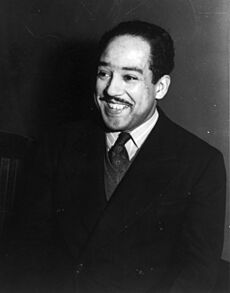
Cleveland has a lively community for writers and poets. Langston Hughes, a famous poet from the Harlem Renaissance, lived in Cleveland as a teenager. He wrote some of his first poems here.
Hart Crane, a well-known poet, was born near Cleveland. He worked as a reporter for The Plain Dealer for a short time.
Joe Shuster and Jerry Siegel, who created the comic book character Superman, were from Cleveland. They went to Glenville High School.
The Anisfield-Wolf Book Award was started in Cleveland in 1935. It gives awards to books that help us understand racism and diversity.
Museums and Art Galleries
Cleveland has two main art museums. The Cleveland Museum of Art has over 60,000 pieces of art, from ancient times to today. The Museum of Contemporary Art Cleveland shows works by new and known artists. Both museums offer free entry.
These museums are in University Circle. This area is a large group of cultural, educational, and medical places. It also includes the Cleveland Botanical Garden, Case Western Reserve University, and the Cleveland Museum of Natural History.
The I. M. Pei-designed Rock and Roll Hall of Fame is on the Lake Erie waterfront. Nearby are the Great Lakes Science Center and the Cod|SS-224|6, a World War II submarine. The Soldiers' and Sailors' Monument at Public Square is a major Civil War memorial. Another fun place is the Christmas Story House and Museum in Tremont, based on the famous movie.
Yearly Events
Cleveland hosts the WinterLand holiday light festival every year. The Cleveland International Film Festival has been held since 1977. The Cleveland National Air Show takes place at Burke Lakefront Airport. Many ethnic festivals are held throughout the year, celebrating Cleveland's diverse communities.
Food in Cleveland
Cleveland's many cultures have shaped its food. You can find lots of Slavic, Hungarian, and Eastern European foods like kielbasa and pierogies. German, Irish, Jewish, and Italian American foods are also popular. The West Side Market in Ohio City sells many different ethnic foods. Cleveland also has a great barbecue and soul food scene.
Cleveland is known for its corned beef sandwiches, especially from Slyman's Deli. The Polish Boy sandwich is a local favorite, often sold at hot dog carts. Many places in Cleveland still have Friday night fish fries, especially during Lent. For dessert, try the Cleveland Cassata Cake or a Russian Tea Biscuit.
Famous local food figures include chef Michael Symon and food writer Michael Ruhlman. Symon won "The Next Iron Chef" on Food Network. Ruhlman worked with Anthony Bourdain on a TV episode about Cleveland's restaurants.
Breweries
Ohio makes a lot of beer, and Cleveland's Great Lakes Brewing Company is the largest brewery in the state. Cleveland has a long history of brewing, thanks to its immigrants. Now, many breweries are in the city, especially in the Ohio City neighborhood.
Sports in Cleveland
Cleveland has three major professional sports teams:
- The Cleveland Guardians (baseball, Major League Baseball)
- The Cleveland Browns (football, National Football League)
- The Cleveland Cavaliers (basketball, National Basketball Association)
Other professional teams include the Cleveland Monsters (hockey) and the Cleveland Charge (basketball). You can watch games at places like Progressive Field, Huntington Bank Field, and Rocket Mortgage FieldHouse.
Professional Teams
Major League
| Club | Sport | League | Venue | Est. in CLE | Championships (in Cleveland) |
|---|---|---|---|---|---|
| Cleveland Browns | Football | National Football League | Huntington Bank Field | 1946 | 8 (4 AAFC, 4 NFL) |
| Cleveland Cavaliers | Basketball | National Basketball Association | Rocket Mortgage FieldHouse | 1970 | 1 |
| Cleveland Guardians | Baseball | Major League Baseball | Progressive Field | 1901 | 2 |
Minor League
| Club | Sport | League | Venue | Est. in CLE | Championships (in Cleveland) |
|---|---|---|---|---|---|
| Cleveland Charge | Basketball | NBA G League | Public Auditorium | 2021 | 0 |
| Cleveland Monsters | Ice hockey | American Hockey League | Rocket Mortgage FieldHouse | 2007 | 1 |
| Cleveland Crunch | Indoor Soccer | Major League Indoor Soccer | Soccer Sportsplex (North Olmsted, Ohio) |
1989 | 5 (3 NPSL, 1 M2, 1 MLIS) |
| Cleveland Pro Soccer | Soccer | MLS Next Pro | TBA | 2022 | 0 |
The Cleveland Guardians (formerly the Indians) won the World Series in 1920 and 1948. They also reached the World Series in 1954, 1995, 1997, and 2016.
The Browns have won eight football titles in their history. They won four championships in the 1940s and four NFL championships in the 1950s and 1960s. The Browns have never played in a Super Bowl.
The Cavaliers won their first NBA Championship in 2016. They came back from being down 3-1 in the series to win! Over 1.3 million people celebrated with a parade in downtown Cleveland. The Cleveland Monsters hockey team won the Calder Cup in 2016.
College Sports
| Club | Sport | League | Venue |
|---|---|---|---|
| Cleveland State Vikings | 19 Varsity (8 men's, 10 women's, 1 co-ed) |
NCAA Division I (Horizon League) |
various – including: Krenzler Field (soccer) Wolstein Center (men's and women's basketball) Woodling Gym (wrestling and volleyball) |
| Case Western Reserve Spartans | 17 Varsity (9 men's, 8 women's) |
NCAA Division III (University Athletic Association) |
various – including: DiSanto Field (football, soccer) Veale Athletic Center (men's and women's basketball) |
Cleveland State University has the Cleveland State Vikings in NCAA Division I. Case Western Reserve University has the Case Western Reserve Spartans in NCAA Division III. The Mid-American Conference (MAC) has its headquarters in Cleveland. They hold their basketball tournaments at Rocket Mortgage FieldHouse.
Special Sports Events
The Cleveland Marathon is held every year. A monument to famous track athlete Jesse Owens stands in Fort Huntington Park. Cleveland has also hosted major chess championships. In 2014, Cleveland hosted the 2014 Gay Games. In July 2024, the city hosted the Pan American Masters Games.
Parks and Fun in Cleveland

The Cleveland Metroparks system is known as the "Emerald Necklace." It surrounds Cleveland and Cuyahoga County with beautiful green spaces. The city has parts of the Metroparks like Brookside and Lakefront Reservations. The Lakefront Reservation offers public access to Lake Erie. It includes parks like Edgewater Park and Gordon Park.
The Cleveland Metroparks Zoo is also part of this system. It started in 1882 and has one of the largest collections of primates in North America.
Besides the Metroparks, the Cleveland Public Parks District manages the city's neighborhood parks. The largest is Rockefeller Park. This park has old bridges and the Cleveland Cultural Gardens. These gardens celebrate the city's many different cultures. The Cleveland Botanical Garden in University Circle is the oldest civic garden center in the U.S. The Greater Cleveland Aquarium is the only independent aquarium in Ohio.
Learning in Cleveland
Schools for Kids
The Cleveland Metropolitan School District is the second-largest school district in Ohio. The mayor directly controls it. A small part of Cleveland's Buckeye–Shaker neighborhood is in the Shaker Heights City School District. This means those Cleveland residents pay the same school taxes as Shaker residents.
Cleveland also has many private and religious schools. These include Benedictine High School and St. Ignatius High School.
Colleges and Universities
Cleveland is home to several colleges and universities. Case Western Reserve University (CWRU) is a well-known research university in University Circle. It has many advanced programs.
University Circle also has the Cleveland Institute of Art and the Cleveland Institute of Music. Downtown Cleveland is home to Cleveland State University, a public research university. Cuyahoga Community College also has a campus downtown.
Public Library System
The Cleveland Public Library started in 1869. It is one of the largest public libraries in the U.S. It has over 10 million items. Its John G. White Special Collection has the world's largest chess library. The main library building was finished in 1925. Between 1904 and 1920, 15 libraries were built in the city with money from Andrew Carnegie. The library has 27 branches today.
Media in Cleveland
Newspapers and Magazines
Cleveland's main daily newspaper is The Plain Dealer. Its online version is Cleveland.com. Other publications include Cleveland Magazine, which covers local culture, and Crain's Cleveland Business, a weekly business newspaper. Cleveland Scene is a free weekly paper.
Several newspapers serve Cleveland's different ethnic groups. These include the Call and Post for the African American community and the Cleveland Jewish News. There are also papers in Russian, Chinese, Italian, and Spanish.
TV Stations
Cleveland has many TV stations. These include WKYC (NBC), WEWS-TV (ABC), WJW (Fox), and WOIO (CBS). The Cleveland TV market is one of the largest in the country.
The Mike Douglas Show, a national talk show, started in Cleveland in 1961. The Morning Exchange on WEWS-TV was a model for Good Morning America.
Radio Stations
Cleveland has many AM and FM radio stations. Music stations are very popular. These include WQAL (hot adult contemporary), WDOK (adult contemporary), and WMMS (active rock). WMMS is also the radio home for the Cleveland Cavaliers and Cleveland Guardians.
News and talk radio stations include WHK and WTAM. WTAM is the main station for the Cavaliers and Guardians. Sports stations include WKNR and WKRK-FM, which are the main stations for the Cleveland Browns.
WKSU is the regional NPR station. College radio stations include WBWC (Baldwin Wallace) and WCSB (Cleveland State). WJMO is the only full-time Spanish language station in the city.
Getting Around Cleveland
Public Transit
Cleveland has a public bus and train system run by the Greater Cleveland Regional Transit Authority (RTA). The train system is called The Rapid. It has three light rail lines (Blue, Green, and Waterfront) and one heavy rail line (Red Line). In 2008, RTA finished the HealthLine, a fast bus line on Euclid Avenue. In 1968, Cleveland was the first city to have a direct train link from downtown to its main airport.
Walking and Biking
Cleveland is a good city for walking. In 2021, it was ranked the 17th most walkable of the 50 largest U.S. cities. The best areas for walking are Downtown, Ohio City, and University Circle. Many people in Cleveland do not need a car.
Roads and Highways
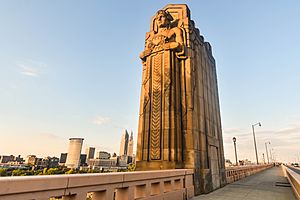
Cleveland's roads have numbered streets going north-south and named avenues going east-west. The numbered streets are "east" or "west" of Ontario Street. Two downtown avenues, Superior Avenue and Carnegie Avenue, change names on the west side of the Cuyahoga River.
Cleveland is served by three major interstate highways: Interstate 71, Interstate 77, and Interstate 90. It also has two smaller interstates, I-480 and I-490. The Cleveland Memorial Shoreway runs along Lake Erie.
Airports
Cleveland is a major air travel market. Cleveland Hopkins International Airport is the city's main airport. It was the first airport in the country owned by a city. Hopkins is also a big hub for air cargo. Cleveland is also served by Burke Lakefront Airport, which is mainly for smaller planes and business travel.
Seaport
The Port of Cleveland, at the mouth of the Cuyahoga River, is a major port on Lake Erie. It receives many raw materials for local industries. It is the only port on the Great Lakes with regular container ship service to Europe. The Port of Cleveland also welcomes tourists on Great Lakes cruises.
Trains and Buses Between Cities
Cleveland has a long history as a major railroad hub. Today, Amtrak provides train service to Cleveland. You can take the Capitol Limited and Lake Shore Limited routes from Cleveland Lakefront Station.
National bus service is provided by Greyhound at the station behind Playhouse Square. Other bus services connect Cleveland to nearby areas.
Cleveland's International Connections
Cleveland has cultural, economic, and educational ties with 28 sister cities around the world. Its first sister city partnership was with Lima, Peru, in 1964. Cleveland is also home to the Consulate General of the Republic of Slovenia.
Historically, Cleveland businessman Cyrus S. Eaton helped promote talks between the U.S. and the Soviet Union during the Cold War. In 1915, Czech American and Slovak American leaders signed the Cleveland Agreement here. This agreement called for the creation of a joint Czech and Slovak state.
| Sister cities of Cleveland |
|---|
|
See also
 In Spanish: Cleveland para niños
In Spanish: Cleveland para niños



